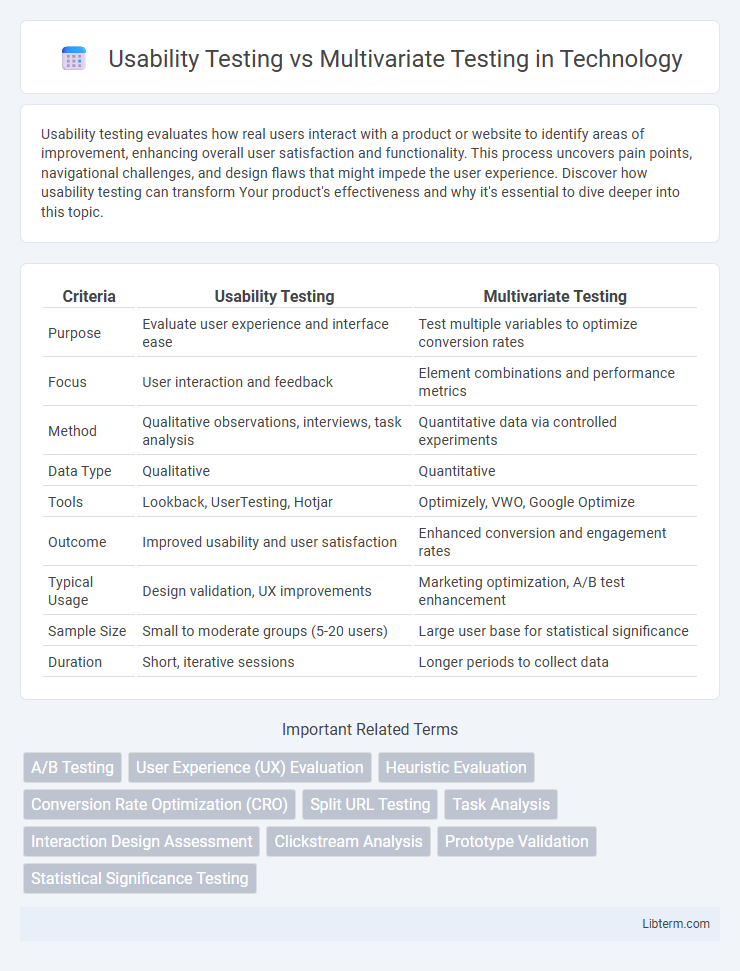Usability testing evaluates how real users interact with a product or website to identify areas of improvement, enhancing overall user satisfaction and functionality. This process uncovers pain points, navigational challenges, and design flaws that might impede the user experience. Discover how usability testing can transform Your product's effectiveness and why it's essential to dive deeper into this topic.
Table of Comparison
| Criteria | Usability Testing | Multivariate Testing |
|---|---|---|
| Purpose | Evaluate user experience and interface ease | Test multiple variables to optimize conversion rates |
| Focus | User interaction and feedback | Element combinations and performance metrics |
| Method | Qualitative observations, interviews, task analysis | Quantitative data via controlled experiments |
| Data Type | Qualitative | Quantitative |
| Tools | Lookback, UserTesting, Hotjar | Optimizely, VWO, Google Optimize |
| Outcome | Improved usability and user satisfaction | Enhanced conversion and engagement rates |
| Typical Usage | Design validation, UX improvements | Marketing optimization, A/B test enhancement |
| Sample Size | Small to moderate groups (5-20 users) | Large user base for statistical significance |
| Duration | Short, iterative sessions | Longer periods to collect data |
Introduction to Usability Testing and Multivariate Testing
Usability testing evaluates how real users interact with a product or website to identify pain points and improve user experience through observation and feedback. Multivariate testing analyzes multiple variable combinations simultaneously to determine the most effective elements for conversion rate optimization. Both methods provide critical insights, with usability testing focusing on user behavior and multivariate testing delivering data-driven design improvements.
Defining Usability Testing
Usability testing evaluates a product's ease of use by observing real users as they complete specific tasks, identifying interface issues and user frustrations. This method prioritizes user experience insights, focusing on navigation, clarity, and efficiency to improve overall satisfaction. Defining usability testing involves measuring how intuitively users interact with a design, ensuring functionality aligns with user expectations.
What is Multivariate Testing?
Multivariate Testing is a research method in digital marketing and web design that evaluates multiple variables simultaneously to determine the most effective combination for user experience optimization. Unlike Usability Testing, which focuses on observing user interactions and identifying usability issues, Multivariate Testing uses statistical analysis to measure the performance impact of various design elements such as headlines, images, and call-to-action buttons. This approach enables data-driven decisions to improve conversion rates by testing different permutations of page components in real time.
Key Objectives of Usability Testing
Usability testing aims to evaluate how easily users can navigate and interact with a product to identify pain points and improve user experience. This method focuses on observing real users performing specific tasks to uncover design flaws and enhance functionality. Unlike multivariate testing, which assesses multiple variable combinations to optimize performance metrics, usability testing prioritizes user satisfaction and intuitive design.
Main Goals of Multivariate Testing
Multivariate testing aims to evaluate multiple variations of web page elements simultaneously to determine the best-performing combination for user engagement and conversion rates. This testing method focuses on identifying the optimal blend of headlines, images, call-to-action buttons, and other components to maximize overall site effectiveness. By analyzing complex interaction effects between variables, multivariate testing provides data-driven insights for iterative design improvements.
Methodologies: Usability vs Multivariate Testing
Usability testing focuses on evaluating a product's user interface and user experience by observing real users as they complete tasks, identifying pain points and areas for improvement through qualitative feedback. Multivariate testing analyzes multiple variables simultaneously by running experiments on different combinations of elements, using quantitative data to determine which combination performs best in achieving specific goals like conversions or engagement. While usability testing emphasizes direct user interaction and insight-based refinement, multivariate testing relies on statistical analysis to optimize design elements at scale.
Tools Commonly Used in Each Approach
Usability testing commonly employs tools such as UserTesting, Lookback, and Hotjar to observe real user interactions and gather qualitative feedback on user experience. Multivariate testing relies on platforms like Optimizely, VWO (Visual Website Optimizer), and Google Optimize to systematically test multiple variations of web elements and analyze performance metrics quantitatively. Both approaches utilize analytics software, but usability testing focuses on behavior insight, whereas multivariate testing emphasizes data-driven optimization for conversion rates.
Advantages and Limitations Comparison
Usability testing offers in-depth qualitative insights into user behavior, revealing specific design issues and enhancing user experience by observing real-time interactions, but it can be time-consuming and limited by small sample sizes. Multivariate testing provides quantitative data by simultaneously testing multiple variables to optimize webpage performance and drive data-driven decisions, yet it requires large traffic volumes for statistical significance and may overlook nuanced user feedback. Both methods complement each other, with usability testing identifying problems and multivariate testing validating solution effectiveness at scale.
When to Use Usability Testing vs Multivariate Testing
Usability testing is ideal for evaluating user experience and identifying interface design issues to improve navigation, accessibility, and overall satisfaction during product development phases. Multivariate testing is best suited for optimizing specific website or app elements by comparing multiple variable combinations simultaneously to determine the most effective design or content variations. Choose usability testing when insights into user behavior and pain points are needed, and opt for multivariate testing to refine conversion rates and feature effectiveness through data-driven experimentation.
Conclusion: Choosing the Right Testing Method
Usability testing provides direct insights into user behavior and interface functionality, ideal for identifying specific design issues and enhancing user experience. Multivariate testing evaluates multiple variables simultaneously to optimize overall conversion rates and marketing strategies through data-driven decisions. Selecting the right testing method depends on whether the primary goal is improving user interaction or maximizing performance outcomes.
Usability Testing Infographic

 libterm.com
libterm.com